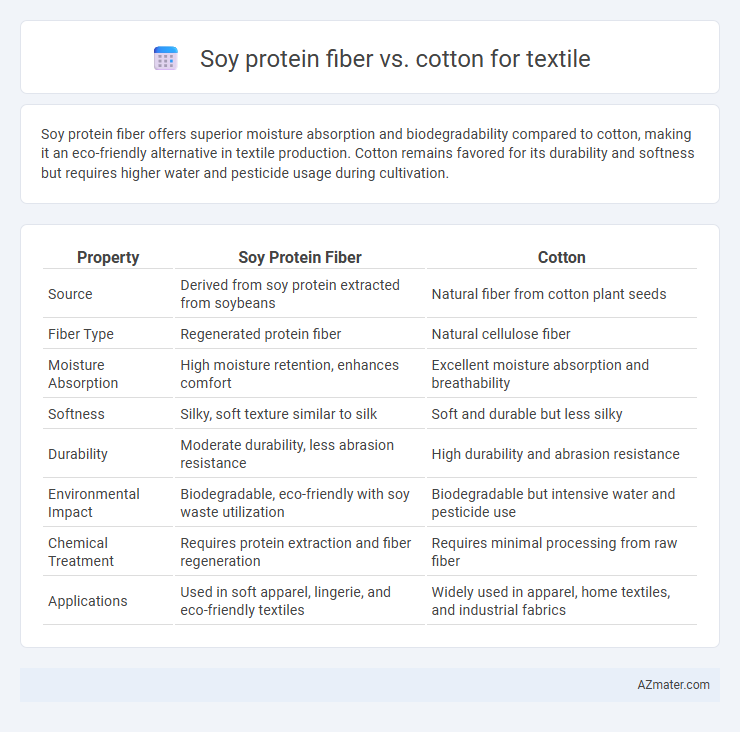Soy protein fiber offers superior moisture absorption and biodegradability compared to cotton, making it an eco-friendly alternative in textile production. Cotton remains favored for its durability and softness but requires higher water and pesticide usage during cultivation.
Table of Comparison
| Property | Soy Protein Fiber | Cotton |
|---|---|---|
| Source | Derived from soy protein extracted from soybeans | Natural fiber from cotton plant seeds |
| Fiber Type | Regenerated protein fiber | Natural cellulose fiber |
| Moisture Absorption | High moisture retention, enhances comfort | Excellent moisture absorption and breathability |
| Softness | Silky, soft texture similar to silk | Soft and durable but less silky |
| Durability | Moderate durability, less abrasion resistance | High durability and abrasion resistance |
| Environmental Impact | Biodegradable, eco-friendly with soy waste utilization | Biodegradable but intensive water and pesticide use |
| Chemical Treatment | Requires protein extraction and fiber regeneration | Requires minimal processing from raw fiber |
| Applications | Used in soft apparel, lingerie, and eco-friendly textiles | Widely used in apparel, home textiles, and industrial fabrics |
Introduction to Soy Protein Fiber and Cotton
Soy protein fiber, derived from soybean meal, offers eco-friendly textile options with natural softness, moisture absorption, and biodegradability. Cotton, a widely cultivated natural fiber, is valued for its breathability, durability, and comfort in textile applications. Both fibers contribute unique properties to fabric production, influencing sustainability, texture, and consumer preference.
Origins and Production Methods
Soy protein fiber, derived from soybean protein through a solvent-spinning process, offers a sustainable alternative to traditional textile fibers by utilizing agricultural byproducts and minimizing environmental waste. Cotton, cultivated from the cotton plant's seed fibers, undergoes mechanical ginning and extensive water-intensive processing to transform raw cotton into usable textile fiber. The distinct origins--soy protein from leguminous plants and cotton from annual crops--alongside their production methods highlight soy protein fiber's eco-friendly approach compared to the resource-heavy cultivation and processing of cotton.
Environmental Impact Comparison
Soy protein fiber offers a sustainable alternative to cotton by requiring less water and fewer pesticides throughout cultivation, significantly reducing environmental strain. Cotton cultivation demands extensive water usage--up to 20,000 liters per kilogram of fiber--and heavy reliance on chemical inputs, leading to soil degradation and biodiversity loss. Soy protein fiber production emits lower greenhouse gases and supports biodegradability, contributing to a reduced ecological footprint in textile manufacturing.
Fiber Structure and Physical Properties
Soy protein fiber exhibits a unique protein-based structure with excellent moisture absorption and a silk-like smoothness, offering superior softness compared to cotton's cellulose-based cellulose fibrils. Soy fibers demonstrate higher elasticity and better resilience, enhancing fabric durability while maintaining breathability and comfort similar to natural cotton. The combination of soy protein's hydrophilic amino groups and cotton's cellulose polymer results in distinct physical properties, making soy protein fiber a sustainable alternative with enhanced tactile qualities for textile applications.
Comfort and Wearability
Soy protein fiber offers exceptional softness and moisture-wicking properties, enhancing comfort and breathability in textile applications. Cotton, renowned for its natural absorbency and durability, provides reliable wearability but may retain moisture longer, affecting comfort. Combining soy protein fiber with cotton in blends often results in fabrics that balance softness, moisture management, and durability for improved all-day wearability.
Moisture Absorption and Breathability
Soy protein fiber exhibits superior moisture absorption compared to cotton, absorbing up to 20% of its weight in water while maintaining a dry surface, enhancing comfort in textile applications. Its breathable structure allows for efficient air circulation, reducing heat retention and improving wearability in warm climates. Cotton, although breathable, tends to retain moisture longer, which can lead to a damp feeling and slower drying times in garments.
Durability and Longevity
Soy protein fiber offers superior durability compared to cotton due to its natural elasticity and resistance to wear and tear, making it ideal for long-lasting textiles. Unlike cotton, which tends to weaken and degrade faster with repeated washing, soy fiber retains strength and shape over extended use. Its resilience against pilling and abrasion ensures textiles maintain a fresh appearance, enhancing overall longevity in various applications.
Dyeing and Color Retention
Soy protein fiber demonstrates superior dye affinity compared to cotton, absorbing dyes more evenly and resulting in richer, more vibrant colors. The protein structure in soy fibers enhances color retention, reducing fading over time when exposed to washing and sunlight. In contrast, cotton tends to lose color faster due to its cellulose composition, which binds dyes less effectively and requires additional chemical treatments for improved colorfastness.
Cost and Market Availability
Soy protein fiber offers a sustainable alternative to cotton with competitive production costs influenced by soy byproduct availability. Cotton maintains a strong market presence due to its established supply chains and lower raw material costs in major producing countries. The fluctuating prices of soy protein fiber and limited scale of manufacturing restrict its widespread market availability compared to the more accessible and cost-efficient cotton.
Future Prospects in Textile Industry
Soy protein fiber offers a sustainable alternative to cotton, with its biodegradable properties and ability to reduce water consumption significantly, positioning it as a key material in the future textile industry. Innovations in bio-engineering enhance soy protein fiber's durability and comfort, addressing current limitations compared to traditional cotton fabrics. The growing consumer demand for eco-friendly textiles and advancements in processing technologies suggest soy protein fiber will increasingly complement or replace cotton in diverse textile applications.

Infographic: Soy protein fiber vs Cotton for Textile
 azmater.com
azmater.com